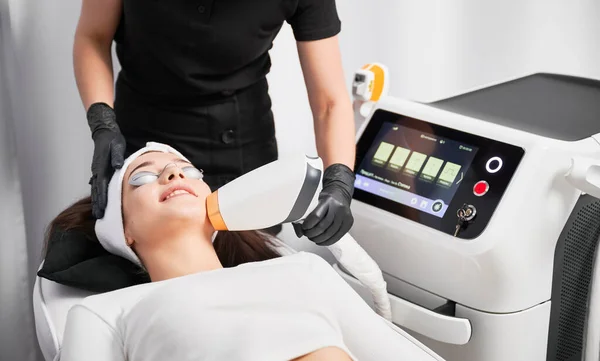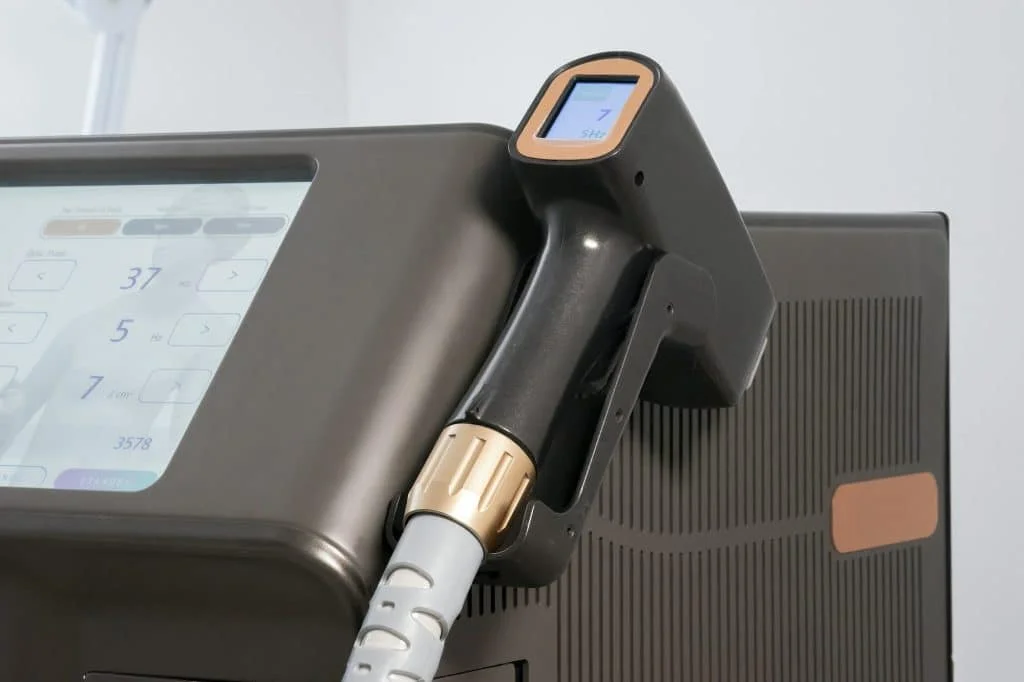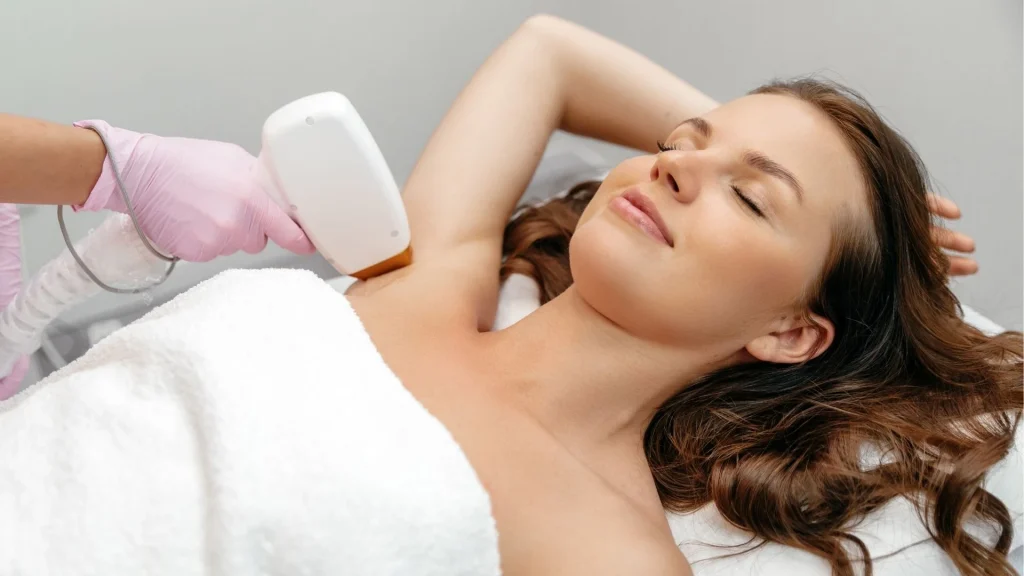What is Laser Hair Removal? Is it Harmful? How Many Sessions Does it Take? How Much Does it Cost?
The skin — our body’s largest and most visible organ — is also one we care deeply about. It dresses us, represents us, and when it’s healthy, it radiates beauty. So how can we make both our skin and ourselves feel more comfortable, confident, and refreshed?
Laser hair removal is one of the most effective methods that offers us long-term comfort, confidence, and smoothness with lasting results.

We know that laser hair removal yields the healthiest and most successful results when performed during the autumn and winter months, when sun exposure is significantly reduced. Now that we’re enjoying the best days of fall, you might be asking yourself:
- “What exactly is laser hair removal?”
- “Which laser type delivers the best results?”
- “What are the current prices for laser hair removal?”
If so, you’re in the right place.
With my laser hair removal certification and use of the industry’s top-rated laser device, I continue to deliver outstanding results to my clients. After the success of my Microblading Guide, I’m excited to share this new resource with you — a comprehensive and trustworthy laser hair removal guide, full of up-to-date information and expert advice.
What Is Laser Hair Removal?
Laser hair removal can be described as one of the most effective solutions for eliminating unwanted body and facial hair. Often referred to as the modern path to smooth skin, this treatment is the preferred choice for those seeking longer-lasting results compared to traditional methods like shaving, waxing, or depilatory creams.
As a light-based procedure, full-body laser hair removal has become one of today’s most popular skincare applications—offering a practical solution for the fast-paced demands of modern life.

So how does laser hair removal actually work? The principle is simple: laser light is absorbed by melanin in the hair follicles, generating heat that weakens the root and prevents regrowth. While the term “permanent hair removal” is commonly used, it can be misleading. With the right technology and consistent sessions, long-term results are absolutely possible—but outcomes vary depending on the individual, skin type, and treatment area.
The key takeaway is this: when asking “What is laser hair removal?”, the answer shouldn’t be reduced to simply removing hair. Its impact on hygiene, aesthetics, comfort, and confidence is equally important and should not be underestimated.
CANAN GENC
A Brief History of Laser Hair Removal
The laser hair removal technologies we use today have gone through five major stages of development:
- 1960s: The first lasers were produced (first-generation). These continuous wave devices lacked control and posed health risks, leading to their discontinuation.
- 1970s: Second-generation lasers were introduced. Using a fiber optic probe, they targeted individual follicles—but difficulties in testing and safety concerns led the FDA to withdraw them.
- 1980s: Third-generation lasers offered better targeting but remained inefficient and impractical, eventually being phased out.
- 1990s: Fourth-generation lasers received FDA approval for medical use. These devices used carbon to heat and shock the follicle but were discontinued due to causing damage to surrounding tissue.

- 1997 onwards: Fifth-generation lasers emerged, targeting melanin directly. FDA-approved, these devices featured built-in cooling systems and far greater ease of use—marking a turning point in safety, precision, and effectiveness. These remain the foundation of today’s advanced laser hair removal technologies.
Types of Laser Hair Removal Technologies
Today, a wide variety of laser hair removal technologies are used worldwide and in Turkey. Each device offers specific advantages depending on your skin tone and hair structure. To find the most effective solution for your individual needs, take a closer look at the laser types below:
- Alexandrite Laser: Yields the best results on light skin tones with dark, coarse hair.
- Diode Laser: Effective even on darker skin tones and finer hair. One frequently asked question is, “Can Diode laser be used on the face?” — Yes, with the correct settings, it is safe and effective for facial areas.
- Ice Laser (Soprano Ice): Uses cooling technology to minimize discomfort. A popular option for those comparing facial laser hair removal prices due to its high comfort level.
- Hybrid Laser: One of the latest innovations, this system combines Alexandrite and Diode technologies. If you’ve asked “What is a hybrid laser?” or “What is hybrid laser hair removal?” — the answer is: a versatile system using multiple wavelengths for broader treatment capabilities.
Which Areas Can Be Treated with Laser Hair Removal?
Laser hair removal can be used on nearly every area of the body to achieve results close to permanent.
- For women, the most common treatment zones include the face, legs, underarms, and bikini line.
- For men, popular areas include the back, chest, and nape of the neck.
When it comes to facial laser treatments, we see excellent results in areas like the glabella (between eyebrows), upper lip, and chin.

But where shouldn’t laser be used? Sensitive zones like the eye area are not suitable for treatment. Beyond that, we determine suitability based on your skin type, hair density, and overall risk factors during your initial consultation.
If you’re looking for a treatment that not only enhances your appearance but also rewards your skin with long-lasting smoothness, feel free to reach out today for a personalized consultation.
Which Body Areas Show the Best Results?
Another common question is: “Which area responds best to laser hair removal?” The answer is: areas with dark, dense hair roots tend to show faster and more permanent results.
For example:
- Legs and underarms typically respond better compared to fine facial hair.
- That said, with the right device (such as Alexandrite, Diode, or Ice Laser) and expert supervision, it’s possible to see highly effective results across nearly all treatment areas.
Is Laser Hair Removal Suitable for Everyone?
While laser hair removal is generally a safe and effective method for most people, that doesn’t mean it’s suitable for everyone. Let’s start by addressing the key question:
Who should avoid laser hair removal?
I do not recommend laser treatments for those who are:
- Pregnant
- Living with active skin conditions
- Experiencing photosensitivity due to certain medications
Additionally, individuals with very light or fine body hair may not see the desired results, as the laser has difficulty targeting such follicles effectively.
One of the most frequently asked questions is:
What happens if laser hair removal is performed over a tattoo?
Laser beams can damage the pigments in the tattooed skin, which is why we avoid direct application over tattoos. However, the surrounding areas can be safely treated.
Which Skin Types Are Not Suitable for Laser Hair Removal?
Thanks to modern hybrid laser technologies, laser hair removal is now compatible with a wider variety of skin tones. However, I recommend postponing treatment on deeply tanned skin or areas affected by sunburn. This helps minimize the risk of side effects and ensures you get the most permanent and safe results possible.
Facial and Eyebrow Laser Hair Removal
The face is one of the most common areas treated with laser hair removal — especially for those looking to remove fine facial hairs from the chin, upper lip, and cheeks.

But is facial laser hair removal truly safe?
Yes — when performed with the correct device and by a trained professional, it is both safe and effective.
For facial areas, the best laser options are:
- Alexandrite
- Diode
- Ice Laser (Soprano Ice) for maximum comfort
Those with sensitive skin may benefit more from hybrid laser systems.
Now, let’s talk about eyebrows.
Laser hair removal is not applied directly within the brow area, as the laser light may pose a risk to eye health.
However, unwanted hairs above the brow (towards the temples) or below the brow line can be treated safely and effectively.
The key here is ensuring the procedure is conducted under the supervision of a qualified specialist with the right training and experience.
How Many Sessions Are Needed for Facial Laser Hair Removal?
The number of laser hair removal sessions for the face varies depending on your skin type, hair color, hair density, and the laser device being used.
In most cases, multiple sessions are required to achieve permanent results. That’s because laser technology targets hairs during their active growth phase. So while you may notice a visible reduction after the first session, we strongly recommend continuing the treatment at regular intervals to achieve lasting smoothness.
We can provide an accurate session plan only after analyzing your skin and hair structure. This is where our personalized approach truly makes a difference.
CANAN GENC
It’s also important to note that facial laser hair removal prices may vary depending on the number of sessions required.
For the best price-performance balance, I recommend choosing a laser center approved by the Ministry of Health.
Post-Treatment Care After Laser Hair Removal
Since laser hair removal delivers direct energy to the skin, aftercare is just as crucial as the procedure itself.
By following the correct steps, you can minimize irritation and maximize the effectiveness of each session.
Post-Laser Cream and Sun Protection
Immediately after the procedure, it’s essential to apply a laser-specific soothing cream. These creams help to calm the skin, reduce redness, and speed up healing.
From day one, I also consider sun protection a critical step.
After laser treatment, the skin becomes more sensitive. That’s why — regardless of the season — using a broad-spectrum sunscreen with at least SPF 30 is extremely important.
Showering and Skin Cleansing
One of the most common questions is:
Can I take a shower after laser hair removal?
Avoid hot showers, scrubbing, or using a loofah during the first 24 hours. Instead, use lukewarm water and opt for unscented, gentle cleansers suitable for sensitive skin.
What Not to Do in the First 24–48 Hours
- Avoid saunas, Turkish baths, steam rooms, and intense workouts (excessive sweating may irritate the skin).
- Do not apply perfumed or alcohol-based products to the treated area.
- Refrain from wearing tight clothing that may cause friction.
- Avoid sun exposure and tanning beds.
Remember: Proper aftercare is critical for the effectiveness of your laser treatment and the health of your skin. With the right cream, sun protection, and a few simple precautions, your recovery process can be smooth, safe, and comfortable.
For expert advice and product recommendations tailored to your skin after laser hair removal, feel free to contact us today.
Laser Hair Removal Prices
Permanent laser hair removal prices remain one of the most frequently asked and searched topics.
Naturally, before beginning treatment, you might find yourself wondering:
- What determines laser hair removal prices?
- Is there a difference in price between Ice Laser and Alexandrite?
- How much does full-body laser hair removal cost?
- What is the typical price range for facial laser hair removal?
Unfortunately, there’s no single number that answers all of these questions — because several factors influence the price.
Factors That Affect Laser Hair Removal Pricing
- Treatment Area: The price per session varies depending on whether the area is the face, legs, underarms, or bikini line.
- Laser Device Technology: Differences between Alexandrite, Diode, Ice Laser, and hybrid laser systems affect both the session duration and long-term effectiveness. For example, when people ask, “Is Soprano or Alexandrite better?” — it’s not only about performance but also about price difference.
- Clinic & Expertise: Procedures performed at a licensed laser center approved by the Ministry of Health, using high-quality devices and carried out by certified professionals, will naturally influence the cost.
Yes, it’s true that laser hair removal pricing varies based on the individual, the area treated, and the technology used.
Full-body treatments and facial laser sessions will not be priced the same — and you can also expect differences between Ice Laser and Alexandrite Laser treatments.
If you’re aiming for a safe and permanent result, price alone should not be your only criteria.
We highly recommend that you also consider device quality and the credibility of the center.
Where Beauty Meets Safety
Beauty isn’t just an aesthetic choice — it’s the result of making informed and safe decisions.
At my clinic, as Canan Genç, I only work with Ministry of Health-approved devices and internationally certified pigments.
In every treatment, whether it’s microblading, permanent eyeliner, or laser hair removal, we prioritize hygiene, certified expertise, and a personalized approach.
Our goal is to help you achieve the most natural-looking and safest results possible.
If you’d like to discover the most suitable method for your skin and get answers to all your questions, feel free to contact me today.
Frequently Asked Questions
Does laser hair removal hurt?
Technologies like Ice Laser significantly reduce pain. Most people experience only a mild tingling or stinging sensation.
How long does laser hair removal last?
It permanently weakens hair follicles. However, due to hormonal changes, touch-up sessions may be needed after a few years.
What should hair be like before a laser session?
There should be no hair above the skin’s surface—only the root should remain. That’s why shaving is recommendedbefore the session, but waxing or tweezing is not.
Is laser hair removal safe?
Yes — when performed with FDA-approved devices, it’s a safe procedure and does not harm the skin’s protective barrier.
What is the best laser hair removal device?
There’s no single answer:
- Alexandrite: Fast and effective for fair skin with dark hair.
- Diode: Safer for darker skin tones.
- Soprano (Ice Laser): Virtually painless.
- Hybrid lasers: Combine multiple benefits.
Can facial hair be removed permanently with laser?
Yes, but device selection is key. For fine facial hair, Diode or Hybrid lasers are usually preferred.
Does the face swell after laser treatment?
Some people may experience slight redness or swelling, but it usually subsides within a few hours.
Can people with dark skin get laser hair removal?
Absolutely. Diode and Hybrid lasers are safe for darker skin tones.
How many sessions are needed for facial laser hair removal?
Most people see results in around 6 sessions, though additional treatments may be required based on hair type.
Does laser lighten the skin tone?
No, laser hair removal does not lighten the skin — it targets hair follicles only.
What is Alexandrite laser hair removal?
Alexandrite laser is one of the most effective methods for fair skin and dark hair.
Its wide spot size makes it ideal for large areas like legs and arms, delivering fast results.
Who is Diode laser hair removal suitable for?
Diode lasers are safe for both light and dark skin tones. A common question is:
“Can Diode be used on the face?”
Yes — thanks to its precise, smaller handpieces, it is safe for facial use as well.
Which is better: Soprano or Alexandrite?
It depends on your skin and hair type:
- Alexandrite excels in speed.
- Soprano (Ice Laser) offers a pain-free experience.
The right choice should consider skin tone, hair density, and sensitivity.
What makes Ice Laser (Soprano) different?
Ice Laser gets its name from its cooling technology, which enhances comfort.
It’s an excellent option for those with a low pain threshold.
Curious about the price of Ice Laser sessions? It varies based on the area and number of sessions.
What is the difference between laser hair removal and IPL?
- Laser hair removal uses a single wavelength of focused light, targeting hair follicles for stronger, faster, and longer-lasting results.
- IPL (Intense Pulsed Light) emits multiple wavelengths, like a flashbulb, resulting in a scattered, less precisetreatment.
Results take longer, and effectiveness often depends on the practitioner’s technique.


